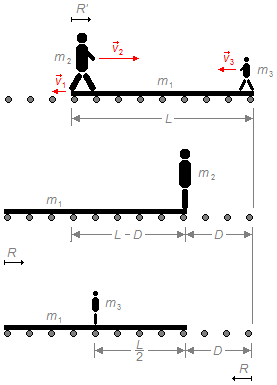Solved Problem on Linear Momentum
advertisement
From the opposite ends of a platform of length L, resting on frictionless rollers, an adult and a child are running toward each other. Determine how far the platform will slide when the adult moves from one end of the platform to the other. It is known that the speed of the adult is twice the speed of the child, and the masses of the platform, the adult, and the child are m1, m2 and m3, respectively.
Problem data:
- Platform length: L;
- Platform mass: m1;
- Adult mass: m2;
- Adult speed: v2;
- Child mass: m3;
- Child speed: v3.
As the man-child-platform system, is isolated from the external forces, the
Law of Conservation of Momentum is valid.
We choose a reference frame on the platform (R'), the man walks the length L of the platform, and as the speed of the child is half the speed of the man, he walks half the length of the platform \( \left(\frac{L}{2}\right) \).
We choose the fixed reference (R) in the water in the same direction as the velocity of the man. When he walks forward, by conservation of momentum, the platform moves backward. The platform moves a distance D to be determined, then relative to the reference frame in the water, the man walks the distance L−D. As the man's speed is greater, he drags the platform with the child backward. Choosing the fixed reference frame (R) in the water in the same direction as the velocity of the child, when the child walks forward, he moves along with the platform. The platform moves a distance of D, and the child moves \( \frac{L}{2} \), so relative to the reference frame in the water the child moves \( \frac{L}{2}+D \).
We choose a reference frame on the platform (R'), the man walks the length L of the platform, and as the speed of the child is half the speed of the man, he walks half the length of the platform \( \left(\frac{L}{2}\right) \).
We choose the fixed reference (R) in the water in the same direction as the velocity of the man. When he walks forward, by conservation of momentum, the platform moves backward. The platform moves a distance D to be determined, then relative to the reference frame in the water, the man walks the distance L−D. As the man's speed is greater, he drags the platform with the child backward. Choosing the fixed reference frame (R) in the water in the same direction as the velocity of the child, when the child walks forward, he moves along with the platform. The platform moves a distance of D, and the child moves \( \frac{L}{2} \), so relative to the reference frame in the water the child moves \( \frac{L}{2}+D \).

Solution
The momentum is given by
\[
\begin{gather}
\bbox[#99CCFF,10px]
{Q=m v}
\end{gather}
\]
The momentum of the man
\( Q_{m} \)
must equal the sum of the momentum of the platform and the child
\( \left(Q_{p}+Q_{c}\right) \)
\[
\begin{gather}
Q_{m}=Q_{p}+Q_{c}\\[5pt]
m_{2}v_{2}=m_{1}v_{1}+m_{3}v_{3}
\end{gather}
\]
the speeds of the platform, the man and the child will be, respectively,
\( v_{1}=\frac{\Delta S_{p}}{\Delta t} \),
\( v_{2}=\frac{\Delta S_{m}}{\Delta t} \)
and
\( v_{3}=\frac{\Delta S_{c}}{\Delta t} \)
\[
\begin{gather}
m_{2}\frac{\Delta S_{m}}{\cancel{\Delta t}}=m_{1}\frac{\Delta S_{p}}{\cancel{\Delta t}}+m_{3}\frac{\Delta S_{c}}{\cancel{\Delta t}}\\[5pt]
m_{2}\Delta S_{m}=m_{1}\Delta S_{p}+m_{3}\Delta S_{c}
\end{gather}
\]
relative to the reference frame in the water, the
displacement of the man will be
\( \Delta S_{m}=L-D \)
(Figure 1), the displacement of the platform will be
\( \Delta S_{p}=D \),
and the displacement of the child will be
\( \Delta S_{c}=\dfrac{L}{2}+D \),
substituting these values in the expression
\[
\begin{gather}
m_{2}(L-D)=m_{1}D+m_{3}\left(\frac{L}{2}+D\right)\\[5pt]
m_{2}L-m_{2}D=m_{1}D+m_{3}\frac{L}{2}+m_{3}D\\[5pt]
m_{2}L-m_{3}\frac{L}{2}=m_{1}D+m_{3}D+m_{2}D
\end{gather}
\]
on the left-hand side of the equation, we multiply and divide the first term by 2, and on the right-hand
side of the equation, we factor D
\[
\begin{gather}
m_{2}L\times\frac{2}{2}-m_{3}\frac{L}{2}=D(m_{1}+m_{3}+m_{2})\\[5pt]
D(m_{1}+m_{3}+m_{2})=2m_{2}\frac{L}{2}-m_{3}\frac{L}{2}
\end{gather}
\]
factoring
\( \dfrac{L}{2} \)
on the right-hand side of the equation
\[
\begin{gather}
D(m_{1}+m_{3}+m_{2})=\frac{L}{2}(2m_{2}-m_{3})
\end{gather}
\]
\[
\begin{gather}
\bbox[#FFCCCC,10px]
{D=\frac{2m_{2}-m_{3}}{m_{1}+m_{3}+m_{2}}\frac{L}{2}}
\end{gather}
\]
advertisement

Fisicaexe - Physics Solved Problems by Elcio Brandani Mondadori is licensed under a Creative Commons Attribution-NonCommercial-ShareAlike 4.0 International License .